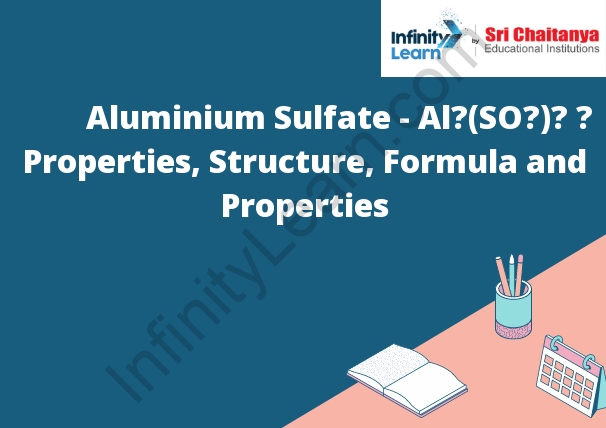Table of Contents
Aluminium Sulfate
Aluminium Sulfate – Al₂(SO₄)₃: Aluminium sulfate is a chemical compound with the formula Al2(SO4)3. It is soluble in water and is used in a variety of industrial processes. Aluminium sulfate is also used as a flocculant to purify water and to improve the clarity of wine and other beverages.

Properties of Aluminium Sulfate Al₂(SO₄)₃
Aluminium sulfate (Al₂(SO₄)₃) is a chemical compound commonly used in various industries and applications. Here are some key properties of aluminium sulfate:
- Chemical Formula: The chemical formula of aluminium sulfate is Al₂(SO₄)₃. It indicates that each molecule of aluminium sulfate contains two aluminium (Al) ions and three sulfate (SO₄) ions.
- Molecular Weight: The molecular weight of aluminium sulfate is approximately 342.15 g/mol.
- Appearance: Aluminium sulfate is usually found as a white, crystalline powder. It can also be found in solid forms, such as flakes or granules.
- Solubility: Aluminium sulfate is highly soluble in water. When dissolved in water, it forms an aqueous solution that is acidic due to the presence of sulfate ions.
- Hydrates: Aluminium sulfate can exist in different hydrate forms, meaning it can combine with water molecules. The most common hydrate forms of aluminium sulfate are the hexadecahydrate (Al₂(SO₄)₃·16H₂O) and octadecahydrate (Al₂(SO₄)₃·18H₂O).
- pH: When aluminium sulfate dissolves in water, it undergoes hydrolysis and releases hydrogen ions (H⁺), resulting in the solution being acidic. The pH of an aluminium sulfate solution typically ranges from 3 to 4.
- Chemical Stability: Aluminium sulfate is relatively stable under normal conditions. However, it can undergo hydrolysis reactions, especially in the presence of moisture or alkaline substances.
Aluminium Sulfate Structure [Al2(SO4)3 Structure]
The structure of aluminium sulfate (Al₂(SO₄)₃) can be described as follows:
- Overall Structure: Aluminium sulfate consists of two aluminium ions (Al³⁺) and three sulfate ions (SO₄²⁻) combined in a specific arrangement.
- Aluminium Ion: Each aluminium ion (Al³⁺) is surrounded by six oxygen atoms arranged octahedrally. The aluminium ion has a +3 charge, which is balanced by the negatively charged sulfate ions.
- Sulfate Ion: Each sulfate ion (SO₄²⁻) is composed of one central sulfur atom bonded to four oxygen atoms in a tetrahedral arrangement. The sulfur atom carries a +6 charge, and the oxygen atoms carry a -2 charge each.
- Connectivity: The aluminium ions and sulfate ions are connected through ionic bonds. The aluminium ions form bonds with the oxygen atoms of the sulfate ions.
- Crystal Structure: Aluminium sulfate forms a crystalline structure. The specific crystal structure depends on the hydrate form. For example, the hexadecahydrate (Al₂(SO₄)₃·16H₂O) adopts an orthorhombic crystal system, while the octadecahydrate (Al₂(SO₄)₃·18H₂O) has a monoclinic crystal system.
It’s important to note that the description provided here is a simplified representation of the structure of aluminium sulfate, focusing on the arrangement of the ions. The actual structure is more complex and involves multiple water molecules in the hydrate forms, which influence the overall crystal structure.
Aluminium Sulfate Formula
Aluminum sulfate is an inorganic compound with the formula Al 2 (SO 4 ) 3 . It is soluble in water and is produced on a large scale as a precursor to other aluminum compounds.
The compound occurs as the mineral kalinite.
Aluminium Sulfate Al2(SO4)3 Uses
- Aluminium sulfate is used in a variety of industries, including the textile, paper, and leather industries.
- It is also used as a flocculant in water and wastewater treatment, as a coagulant in the production of alumina, and as a mordant in dyeing.
- Aluminium sulfate is a colourless solid that is soluble in water. It is used in a variety of industries, including the papermaking, textile, and leather industries.
- Aluminium sulfate is used as a flocculant in the papermaking industry. It is added to the papermaking process to help the tiny paper fibers clump together. This makes the paper stronger and less likely to tear.
- Aluminium sulfate is also used as a coagulant in the textile industry. It is added to the textile manufacturing process to help the tiny textile fibers clump together. This makes the textiles stronger and less likely to tear.
- Aluminium sulfate is also used as a tanning agent in the leather industry. It is added to the leather manufacturing process to help the leather fibers clump together. This makes the leather stronger and less likely to tear.







